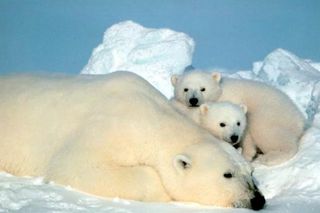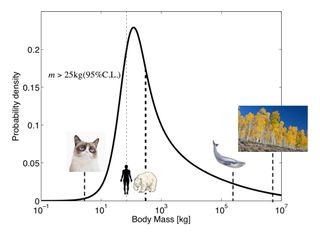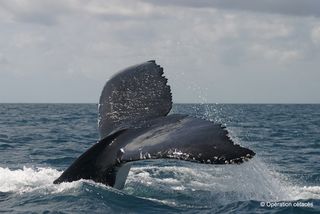Aliens May Be Polar Bear-Sized*

*According to statistics.
How big and powerful would aliens be compared to humans? The answer that we can currently give is of course limited, because we haven’t found any evidence for extraterrestrial life, yet. But a little statistics knowledge suggests we may beway underestimating a typical alien’s stature.
PHOTOS: What We Think Martians Look Like
The University of Barcelona’s Fergus Simpson just conducted a thought experiment along these lines. On a website explaining a recently published paper, he suggests going up to fans of English football (soccer) and asking them to name favourite teams. Most of them will cite the exceptional ones, even though there are 5,000 teams in football that pull in far less revenue and far fewer fans.
Even in an unbiased sample — such as ranking countries by population size — a typical country would be Slovakia, which has a population of 5 million. That far pales with the populations of countries such as China, India and the United States and would likely not get a mention in a similar “name a country” survey.

ANALYSIS: Has Kepler Discovered an Alien Megastructure?
“The properties of your country, and your football club, are unlikely to be a fair reflection of most other countries and most other clubs,” Simpson wrote on a website explaining the research, The Big Alien Theory. The punchline? When it comes to aliens, the “average” size (he says) is likely to be roughly 310 kilograms, or 683 pounds. That’s about the mass of a polar bear.
Get the Space.com Newsletter
Breaking space news, the latest updates on rocket launches, skywatching events and more!
To come up with this figure, first Simpson surveyed Earth’s range of species and made a few observations. Species that are larger physically will have lower population densities (think, insects vs. whales). Given that everything in the universe is subject to the laws of thermodynamics — meaning, larger species consume more energy — this is probably a common theme across the universe.
How Aliens Can Find Us (and Vice Versa)
Some aliens may be very energy-efficient or live in very different environments than ours, but Simpson argues we aren’t looking at the outliers. We are thinking about the average alien. Simpson then compared a typical human with the range of species of Earth. Turns out on Earth, we are slightly below average. The polar bear is more typical — and that’s likely where the average alien’s size would lie.

The Most Horrific Alien Planets In Our Galaxy
“What does this value of 310 kg really mean? Think of it like a spread bet in a sporting event. If a strong team plays a weak team, bookmakers offer a handicap of several points to the weaker team in order to ensure the odds of each team winning are even, at 50 percent,” Simpson wrote.
“It’s a similar situation here – it’s not that we should expect an alien species to be exactly 310 kg, but there is an equal chance of an alien species being heavier or lighter than 310 kg.”
To check out the theory for yourself, head over to Simpson’s website or read his prepublished paper on Arxiv.
Originally published on Discovery News.
Join our Space Forums to keep talking space on the latest missions, night sky and more! And if you have a news tip, correction or comment, let us know at: community@space.com.

Elizabeth Howell (she/her), Ph.D., is a staff writer in the spaceflight channel since 2022 covering diversity, education and gaming as well. She was contributing writer for Space.com for 10 years before joining full-time. Elizabeth's reporting includes multiple exclusives with the White House and Office of the Vice-President of the United States, an exclusive conversation with aspiring space tourist (and NSYNC bassist) Lance Bass, speaking several times with the International Space Station, witnessing five human spaceflight launches on two continents, flying parabolic, working inside a spacesuit, and participating in a simulated Mars mission. Her latest book, "Why Am I Taller?", is co-written with astronaut Dave Williams. Elizabeth holds a Ph.D. and M.Sc. in Space Studies from the University of North Dakota, a Bachelor of Journalism from Canada's Carleton University and a Bachelor of History from Canada's Athabasca University. Elizabeth is also a post-secondary instructor in communications and science at several institutions since 2015; her experience includes developing and teaching an astronomy course at Canada's Algonquin College (with Indigenous content as well) to more than 1,000 students since 2020. Elizabeth first got interested in space after watching the movie Apollo 13 in 1996, and still wants to be an astronaut someday. Mastodon: https://qoto.org/@howellspace
